Sexual differentiation of contextual fear responses
- PMID: 29661835
- PMCID: PMC5903402
- DOI: 10.1101/lm.047159.117
Sexual differentiation of contextual fear responses
Abstract
Development and sex differentiation impart an organizational influence on the neuroanatomy and behavior of mammalian species. Prior studies suggest that brain regions associated with fear motivated defensive behavior undergo a protracted and sex-dependent development. Outside of adult animals, evidence for developmental sex differences in conditioned fear is sparse. Here, we examined in male and female Long-Evans rats how developmental age and sex affect the long-term retention and generalization of Pavlovian fear responses. Experiments 1 and 2 describe under increasing levels of aversive learning (three and five trials) the long-term retrieval of cued and context fear in preadolescent (P24 and P33), periadolescent (P37), and adult (P60 and P90) rats. Experiments 3 and 4 examined contextual processing under minimal aversive learning (1 trial) procedures in infant (P19, P21), preadolescent (P24), and adult (P60) rats. Here, we found that male and female rats display a divergent developmental trajectory in the expression of context-mediated freezing, such that context fear expression in males tends to increase toward adulthood, while females displayed an opposite pattern of decreasing context fear expression toward adulthood. Longer (14 d) retention intervals produced an overall heightened context fear expression relative to shorter (1 d) retention intervals an observation consistent with fear incubation. Male, but not Female rats showed increasing generalization of context fear across development. Collectively, these findings provide an initial demonstration that sexual differentiation of contextual fear conditioning emerges prior to puberty and follows a distinct developmental trajectory toward adulthood that strikingly parallels sex differences in the etiology and epidemiology of anxiety and trauma- and stressor-related disorders.
© 2018 Colon et al.; Published by Cold Spring Harbor Laboratory Press.
Figures





References
-
- Akers KG, Arruda-Carvalho M, Josselyn SA, Frankland PW. 2012. Ontogeny of contextual fear memory formation, specificity, and persistence in mice. Learn Mem 19: 598–604. - PubMed
-
- Anagnostaras SG, Maren S, DeCola JP, Lane NI, Gale GD, Schlinger BA, Fanselow MS. 1998. Testicular hormones do not regulate sexually dimorphic Pavlovian fear conditioning or perforant-path long-term potentiation in adult male rats. Behav Brain Res 92: 1–9. - PubMed
-
- Balogh SA, Radcliffe RA, Logue SF, Wehner JM. 2002. Contextual and cued fear conditioning in C57BL/6J and DBA/2J mice: context discrimination and the effects of retention interval. Behav Neurosci 116: 947–957. - PubMed
-
- Baker KD, Bisby MA, Richardson R. 2016. Impaired fear extinction in adolescent rodents: behavioural and neural analyses. Neurosci Biobehav Rev 70: 59–73. - PubMed
Publication types
MeSH terms
Grants and funding
LinkOut - more resources
Full Text Sources
Other Literature Sources
